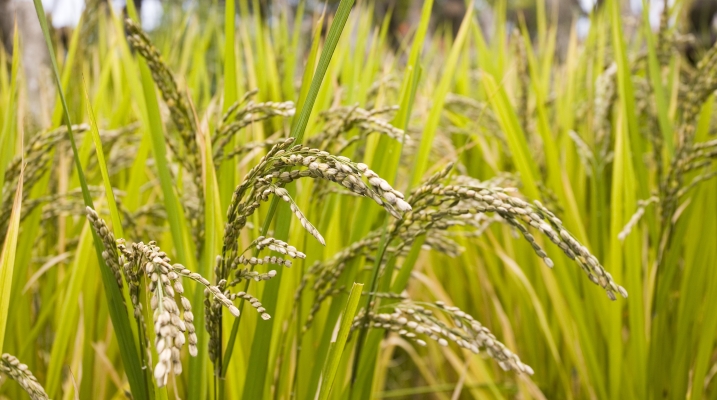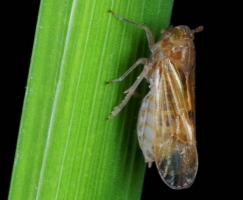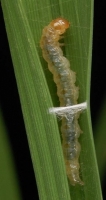Ratna: This variety gives an average yield of 16-18qtl/acre. It has long and thin seed and is good in taste. The variety gets mature in 120-125 days. The variety is resistant to pest borer. It is a late sowing variety.
BK 79: It is a dwarf variety with long and thin grains having basmati properties. It gives an average yield of 18-20 qtl/acre. The variety gets mature in 120-135 days and the variety is resistant to pest and diseases.
Jaya: It gives an average yield of 22-23 qtl/acre. It has thick and heavy grains. The variety gets mature in approximately 135-140 days. The variety is suitable to grow in alkaline land. Transplanting of seedlings must be done till 15thJuly.
Kasturi (IET 8580): It has thin and long grain which is glossy and aromatic. It is medium sized variety which gets mature in 130-135 days. It gives an average yield of 16-18 qtl/acre.
Basmati 370: It is aromatic rice having grain length of 6-7mm and width of 1.7mm. The variety gets mature in 140-145 days and gives an average yield of 10-12 qtl/acre.
Khushboo: It is an early maturing variety which get matures in 118-125 days. It is a medium length variety. It gives an average yield of 16-18 qtl/acre. The grain is approximately 7-7.5m long which is white in color and is aromatic. It is resistant to pests and diseases.
Taraori Basmati: Long height variety which gets mature in 118-125 days. It gives an average yield of 11-12 qtl/acre. The grain is 7-7.4mm long and is white in color and is aromatic. After boiling the rice grows taller than its usual size and does not get cracked or sticked. It requires 25 qtl/acre of Nitrogen for their growth.
MahiSugandha: Basmati variety. It gives an average yield of 14-16 qtl/acre. The variety gets mature in 130-135 days.
PHB 71: It is a semi dwarf variety of hybrid variety. It has an average 100-110cm plant height. The variety gets mature in 130-135 days and it gives an average yield of 22-24 qtl/acre.
Improved Pusa Basmati 1 (P 1460): It is a semi dwarf variety of basmati. It gets mature in 130-138 days and gives an average yield of 16-18 qtl/acre. The variety is moderate resistant to blast, stem borer and pests.
Pusa Sugandha 4 (P 1121): It is the medium size variety of basmati rice. The variety gets mature in 130-135 days. The variety is moderately resistant to blast, stem borer and bacterial infestations.
Pusa Sugandha 5 (P 2511): It is medium size variety having 110-115cm of plant height. It gives an average yield of 18-20qtl/acre. This variety has long, aromatic and has deliciously taste grains. The variety gets mature in 130-135 days. The variety is moderately resistant to disease and pests.
Pratap Sugandha 1 (RSK 1091-10-1-1): It is a medium sized variety (i.e. 150-120cm) which gets mature in 135-140 days. It gives an average yield of 18-20 qtl/acre. It has long and thin grains. The variety is moderately resistant to blast, bacterial infestations and stem borer.
Pusa Basmati 1509: It is a medium size variety (i.e. 100-150cm plant height) which gets mature in 120-125 days and gives an average yield of 18-20 qtl/acre. The variety is moderately resistant to bacterial infestation and blast and is moderately tolerant to pests.
PR 106: It has 100cm plant height. The variety gets mature in 140-145 days.
BK 190: The variety gets mature in 140-145 days. It gives an average yield of 29-32 qtl/acre.
Other state varieties:
PR 111: It is short-statured, stiff strewed variety and it leave are erect and dark green in color. It matures in 135 days. Its grains are long, slender and clear. It is resistant bacterial leaf blight disease and gives average yield of 27 qtl/acre.
PR 113: It is short-statured, stiff strewed variety and its leave is erect and dark green in color. It matures in 142 days. Grain is bold and heavy. It is resistant bacterial leaf blight disease and gives average yield of 28 qtl/acre.
PR 114: It is semi-dwarf, stiff strewed variety having narrow, dark green erect leaves. It matures in 145 days. Its grains are extra-long, clear translucent grains with very good cooking quality. It gives average yield of 27.5 qtl/acre.
PR 115: It is semi-dwarf, stiff strewed variety having narrow, dark green erect leaves. It matures in 125 days. Its grains are long slender, translucent with good cooking quality. It gives average yield of 25 qtl/acre.
PR 116: It is semi-dwarf, stiff strewed variety. It shows resistant to lodging. Its leaves are light green and erect. It matures in 144 days. Its grains are long, slender and translucent. Its average yield is 28 quintals/acre.
PR 118: It is a semi-dwarf, stiff strewed and lodging tolerant variety. Its leaves are dark green and leaves are erected. It matures in 158 days. Its grains are medium slender with good cooking quality. Its average yield is 29 qtl/acre.
PR 120: It is semi dwarf variety with long slender and translucent grains with high cooking quality. It matures in 132 days. It gives average yield of 28.5 qtl/acre.
PR 121: It is short, stiff strewed variety. It shows resistant to lodging. Its leaves are dark green and erect. It matures in 140 days. Its grains are long, slender and translucent. It is resistive to bacterial blight pathogen. It gives average yield of 30.5qtl/acre.
PR 122: It is semi-dwarf, stiff strewed variety having dark green erect leaves. It matures in 147 days. It possesses long slender translucent grains with good cooking quality. It gives average yield of 31.5qtl/acre.
PR 123: It is semi dwarf, stiff strewed variety with dark green and erect leaves. Its grains are long, slender and translucent. It is moderately resistant to bacterial blight pathogen. It gives average yield of 29 qtl/acre.
PR 126: This variety is released by PAU for general cultivation in Punjab. It is an early maturing which gets mature in 123 days after transplanting. The variety is resistant to bacterial blight disease. It gives an average yield of 30 qtl/acre.
HKR 47: This is Semi dwarf variety having high yield with long slender and golden color grains. It is resistant to false smut disease. It matures in 135 days. It is prone to lodging.
CSR 30: The variety has extra-long slender shaped grains which are known for its excellent cooking and good eating qualities. The variety gets mature within 142 days after transplanting. It gives an average yield of 13.5 qtls/acre.










.png)


.png)
.png)
.png)
.png)
.png)
.png)










